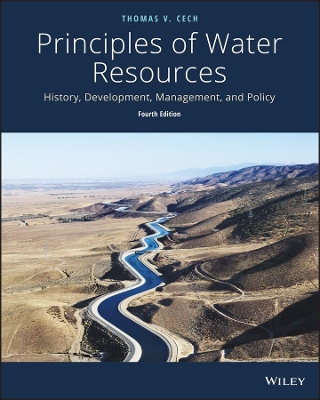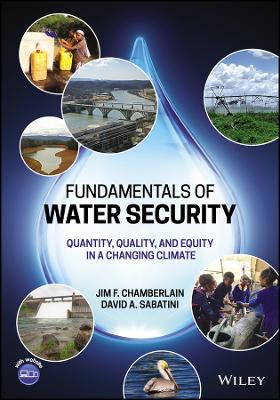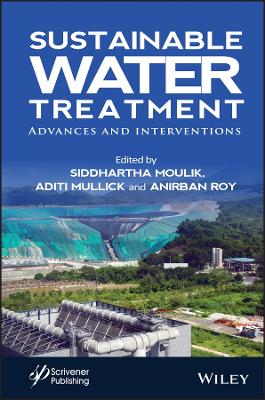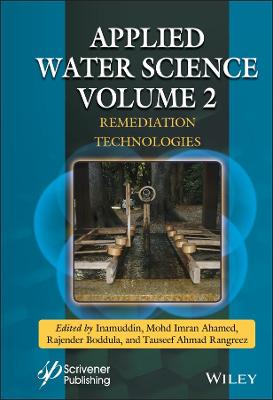Integrated Sustainable Urban Water, Energy, and Solids Management
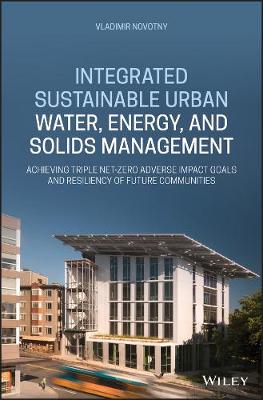 -15%
portes grátis
-15%
portes grátis
Integrated Sustainable Urban Water, Energy, and Solids Management
Achieving Triple Net-Zero Adverse Impact Goals and Resiliency of Future Communities
Novotny, Vladimir
John Wiley & Sons Inc
03/2020
416
Dura
Inglês
9781119593652
15 a 20 dias
1074
Descrição não disponível.
Preface xi
Integrated Sustainable Urban Water, Energy, and Solids Management 1
1 Sustainability Goals for Urban Water and Solid Waste Systems 3
1.1 Introduction to Urban Sustainability / 3
1.2 Historic and Current Urban Paradigms / 8
Paradigms of Urbanization / 9
1.3 Global Climate Changes / 14
1.4 Need for a Paradigm Shift to Sustainability / 16
1.5 Population Increase, Urbanization, and the Rise of Megalopolises / 19
Waste Accumulation / 23
Brief Outlook Toward the Future / 23
1.6 What Is a Sustainable Ecocity? / 24
Impact of Global Warming and Continuing Overuse of Resources / 28
The UN 2015 Resolution of Sustainability / 28
2 the New Paradigm of Urban Water, Energy, and Resources Management 31
2.1 The Search for a New Paradigm / 31
2.2 From Linear to Hybrid Urban Metabolism / 33
Circular Economy / 37
2.3 Urban Resilience and Adaptation to Climate Change / 40
Engineering and Infrastructure Hazards and Disaster Resilience / 42
Socioecological or Governance Resilience / 48
3 Goals and Criteria of Urban Sustainability 51
3.1 Review of Existing Sustainability Criteria / 51
LEED Criteria for Buildings and Subdivisions / 53
Triple Net-Zero (TNZ) Goals / 54
Water Footprint / 56
GHG (Carbon Dioxide) Net-Zero Footprint Goal / 58
Water/Energy Nexus / 60
Ecological Footprint / 60
3.2 Zero Solid Waste to Landfill Goal and Footprint / 61
Landfill Gas (LFG) / 64
Exporting Garbage / 68
Swedish Recycling Revolution / 68
3.3 Importance of Recycling versus Combusting or Landfilling / 69
4 Origin of Hydrogen Energy, GHG Emissions, And Climatic Changes 73
4.1 Introduction to Energy / 73
Energy Definitions and Units / 73
Greenhouse Gases (GHGs) / 76
4.2 Hydrogen Energy / 79
Blue and Green Sources of Hydrogen on Earth / 79
Hydrogen as a Source of Energy / 84
Vision of Hydrogen Role in the (Near) Future / 89
4.3 Carbon Dioxide Sequestering and Reuse / 91
Stopping the Atmospheric CO2 Increase and Reversing the Trend / 91
Sequestering CO2 / 93
Non-CCUS Reuse of Carbon Dioxide / 96
Recycling / 97
4.4 Solar and Wind Blue Power / 98
Solar Power / 98
Wind Power / 103
Green and Blue Energy Storage / 106
4.5 Food/Water/Energy/Climate Nexus / 108
4.6 World and US Energy Outlook / 110
5 Decentralized Hierarchical Urban Water, Used Water, Solids, and Energy Management Systems 117
5.1 Economy of Scale Dogma Forced Centralized Management 45 Years Ago / 117
5.2 Distributed Building and Cluster Level Designs and Management / 119
Cluster or Neighborhood Level Water and Energy Recovery / 121
5.3 Flow Separation: Gray Water Reclamation and Reuse / 126
Tap a Sewer, Keep the Liquid, and Sell the Solids / 132
Integrated District Water and Energy Providing Loop / 136
Energy Savings and GHG Reduction by Gray Water Reuse in Clusters / 137
6 Biophilic Sustainable Landscape and Low Impact Development 141
6.1 Urban Nature and Biophilic Designs / 141
Biophilic Designs / 142
6.2 Low-Impact Development / 144
Classification of LID (SUDS) Practices / 149
6.3 Restoring, Daylighting, and Creating Urban Water Bodies / 165
Stream Restoration / 165
Waterscapes / 169
Vertical Forests and Systems / 170
6.4 Biophilic Urban Biomass Management and Carbon Sequestering / 171
Lawns and Grass Clippings / 172
Other Vegetation / 172
7 Building Blocks of the Regional Integrated Resources Recovery Facility (IRRF) 175
7.1 Traditional Aerobic Treatment / 175
GHG Emissions from Traditional Regional Water/Resources Recovery Facilities / 178
7.2 Energy-Producing Treatment / 179
Anaerobic Digestion and Decomposition / 179
Comparison of Aerobic and Anaerobic Treatment and Energy Recovery (Use) Processes / 182
Acid Fermentation and Its Hydrogen Production / 184
Anaerobic Treatment / 188
7.3 Triple Net-Zero: COF Future Direction and Integrated Resource Recovery Facilities / 189
Goals of the Future IRRFs and Enabling Technologies / 190
Energy Recovery in a Centralized Concept with Anaerobic Treatment and Digestion as the Core Technology / 192
Anaerobic Energy Production and Recovery Units and Processes / 194
High Rate Anaerobic Treatment Systems / 195
7.4 Co-Digestion of Sludge with Other Organic Matter / 203
7.5 Conversion of Chemical and Sensible Energy in Used Water into Electricity and Heat / 207
8 Integrating Gasification and Developing An Integrated "waste to Energy" Power Plant 211
8.1 Traditional Waste-to-Energy Systems / 211
Incineration / 212
Heat Energy to Dry the Solids / 215
8.2 Pyrolysis and Gasification / 216
Gasification of Digested Residual Used Water Solids with MSW / 218
Gasification of Municipal Solid Wastes (MSW) / 221
8.3 Converting Biogas to Electricity / 232
Steam Methane Reforming (SMR) to Syngas and Then to Hydrogen / 234
8.4 Microbial Fuel Cells (MFCs) and Microbial Electrolysis Cells (MECs) / 235
Increasing Hydrogen Energy Production / 236
Microbial Fuel Cells (MFCs) / 236
Modifications of MFCs to MECs for Hydrogen Production / 238
Hybrid Fermentation and the MEC System / 241
8.5 Hydrogen Yield Potential by Indirect Gasification / 242
Sources of Energy Hydrogen / 244
Maximizing Hydrogen Energy Yield by Selecting the Proper Technologies / 251
8.6 Hydrogen Fuel Cells / 249
Molten Carbonate Fuel Cells (MCFCs) / 250
Solid Oxide Fuel Cells (SOFCs) / 253
Producing Hydrogen and Oxygen by Electrolysis / 254
Gas Separation / 256
8.7 The IRRF Power Plant / 257
Hydrogen-CO2 Separator / 260
Carbon Dioxide Sequestering in an IRRF / 262
Carbon Dioxide Capture and Concentration by the Molten Carbonate Fuel Cell / 264
9 Nutrient Recovery 265
9.1 The Need to Recover, Not Just Remove Nutrients / 265
9.2 Biological Nutrient Removal and Recovery / 267
Traditional Nutrient Removal Processes / 267
Anammox / 268
Phosphorus Biological Removal and Limited Recovery / 270
MEC Can Recover Struvite / 272
9.3 Unit Processes Recovering Nutrients / 273
Urine Separation / 273
Nutrient Separation / 274
Phytoseparation of Nutrients / 275
Chemical Removal and Recovery of Nutrients / 283
Phosphorus Flow in the Distributed Urban System / 285
Nutrients in Gasifier Ash / 286
10 Building the Sustainable Integrated System 291
10.1 Assembling the System / 291
Concepts, Building Blocks, and Inputs / 291
10.2 Upgrading Traditional Systems to Cities of the Future / 295
Milwaukee (Wisconsin) Plan / 295
Danish Billund BioRefinery / 296
Integrating MSW / 299
10.3 Visionary Mid-Twenty-First Century Regional Resource Recovery Alternative / 304
The Power Plant / 309
10.4 Water-Energy Nexus and Resource Recovery of Three Alternative Designs / 311
Three Alternatives / 311
Inputs to the Analyses / 315
CO2 /Kw-h Ratio for the Alternatives / 319
Discussion and Results / 321
11 Closing the Quest Toward Triple Net-zero Urban Systems 337
11.1 Community Self-Reliance on TMZ System for Power and Recovering Resources / 337
11.2 Economic Benefits and Approximate Costs of the 2040+ Integrated Water/Energy/MSW Management / 341
Cost of Green and Blue Energies Is Decreasing / 342
11.3 Can It Be Done in Time to Save the Earth from Irreversible Damage? / 349
Political-Economical Tools / 349
The Process to Achieve the Goals / 351
References 357
Index 385
Integrated Sustainable Urban Water, Energy, and Solids Management 1
1 Sustainability Goals for Urban Water and Solid Waste Systems 3
1.1 Introduction to Urban Sustainability / 3
1.2 Historic and Current Urban Paradigms / 8
Paradigms of Urbanization / 9
1.3 Global Climate Changes / 14
1.4 Need for a Paradigm Shift to Sustainability / 16
1.5 Population Increase, Urbanization, and the Rise of Megalopolises / 19
Waste Accumulation / 23
Brief Outlook Toward the Future / 23
1.6 What Is a Sustainable Ecocity? / 24
Impact of Global Warming and Continuing Overuse of Resources / 28
The UN 2015 Resolution of Sustainability / 28
2 the New Paradigm of Urban Water, Energy, and Resources Management 31
2.1 The Search for a New Paradigm / 31
2.2 From Linear to Hybrid Urban Metabolism / 33
Circular Economy / 37
2.3 Urban Resilience and Adaptation to Climate Change / 40
Engineering and Infrastructure Hazards and Disaster Resilience / 42
Socioecological or Governance Resilience / 48
3 Goals and Criteria of Urban Sustainability 51
3.1 Review of Existing Sustainability Criteria / 51
LEED Criteria for Buildings and Subdivisions / 53
Triple Net-Zero (TNZ) Goals / 54
Water Footprint / 56
GHG (Carbon Dioxide) Net-Zero Footprint Goal / 58
Water/Energy Nexus / 60
Ecological Footprint / 60
3.2 Zero Solid Waste to Landfill Goal and Footprint / 61
Landfill Gas (LFG) / 64
Exporting Garbage / 68
Swedish Recycling Revolution / 68
3.3 Importance of Recycling versus Combusting or Landfilling / 69
4 Origin of Hydrogen Energy, GHG Emissions, And Climatic Changes 73
4.1 Introduction to Energy / 73
Energy Definitions and Units / 73
Greenhouse Gases (GHGs) / 76
4.2 Hydrogen Energy / 79
Blue and Green Sources of Hydrogen on Earth / 79
Hydrogen as a Source of Energy / 84
Vision of Hydrogen Role in the (Near) Future / 89
4.3 Carbon Dioxide Sequestering and Reuse / 91
Stopping the Atmospheric CO2 Increase and Reversing the Trend / 91
Sequestering CO2 / 93
Non-CCUS Reuse of Carbon Dioxide / 96
Recycling / 97
4.4 Solar and Wind Blue Power / 98
Solar Power / 98
Wind Power / 103
Green and Blue Energy Storage / 106
4.5 Food/Water/Energy/Climate Nexus / 108
4.6 World and US Energy Outlook / 110
5 Decentralized Hierarchical Urban Water, Used Water, Solids, and Energy Management Systems 117
5.1 Economy of Scale Dogma Forced Centralized Management 45 Years Ago / 117
5.2 Distributed Building and Cluster Level Designs and Management / 119
Cluster or Neighborhood Level Water and Energy Recovery / 121
5.3 Flow Separation: Gray Water Reclamation and Reuse / 126
Tap a Sewer, Keep the Liquid, and Sell the Solids / 132
Integrated District Water and Energy Providing Loop / 136
Energy Savings and GHG Reduction by Gray Water Reuse in Clusters / 137
6 Biophilic Sustainable Landscape and Low Impact Development 141
6.1 Urban Nature and Biophilic Designs / 141
Biophilic Designs / 142
6.2 Low-Impact Development / 144
Classification of LID (SUDS) Practices / 149
6.3 Restoring, Daylighting, and Creating Urban Water Bodies / 165
Stream Restoration / 165
Waterscapes / 169
Vertical Forests and Systems / 170
6.4 Biophilic Urban Biomass Management and Carbon Sequestering / 171
Lawns and Grass Clippings / 172
Other Vegetation / 172
7 Building Blocks of the Regional Integrated Resources Recovery Facility (IRRF) 175
7.1 Traditional Aerobic Treatment / 175
GHG Emissions from Traditional Regional Water/Resources Recovery Facilities / 178
7.2 Energy-Producing Treatment / 179
Anaerobic Digestion and Decomposition / 179
Comparison of Aerobic and Anaerobic Treatment and Energy Recovery (Use) Processes / 182
Acid Fermentation and Its Hydrogen Production / 184
Anaerobic Treatment / 188
7.3 Triple Net-Zero: COF Future Direction and Integrated Resource Recovery Facilities / 189
Goals of the Future IRRFs and Enabling Technologies / 190
Energy Recovery in a Centralized Concept with Anaerobic Treatment and Digestion as the Core Technology / 192
Anaerobic Energy Production and Recovery Units and Processes / 194
High Rate Anaerobic Treatment Systems / 195
7.4 Co-Digestion of Sludge with Other Organic Matter / 203
7.5 Conversion of Chemical and Sensible Energy in Used Water into Electricity and Heat / 207
8 Integrating Gasification and Developing An Integrated "waste to Energy" Power Plant 211
8.1 Traditional Waste-to-Energy Systems / 211
Incineration / 212
Heat Energy to Dry the Solids / 215
8.2 Pyrolysis and Gasification / 216
Gasification of Digested Residual Used Water Solids with MSW / 218
Gasification of Municipal Solid Wastes (MSW) / 221
8.3 Converting Biogas to Electricity / 232
Steam Methane Reforming (SMR) to Syngas and Then to Hydrogen / 234
8.4 Microbial Fuel Cells (MFCs) and Microbial Electrolysis Cells (MECs) / 235
Increasing Hydrogen Energy Production / 236
Microbial Fuel Cells (MFCs) / 236
Modifications of MFCs to MECs for Hydrogen Production / 238
Hybrid Fermentation and the MEC System / 241
8.5 Hydrogen Yield Potential by Indirect Gasification / 242
Sources of Energy Hydrogen / 244
Maximizing Hydrogen Energy Yield by Selecting the Proper Technologies / 251
8.6 Hydrogen Fuel Cells / 249
Molten Carbonate Fuel Cells (MCFCs) / 250
Solid Oxide Fuel Cells (SOFCs) / 253
Producing Hydrogen and Oxygen by Electrolysis / 254
Gas Separation / 256
8.7 The IRRF Power Plant / 257
Hydrogen-CO2 Separator / 260
Carbon Dioxide Sequestering in an IRRF / 262
Carbon Dioxide Capture and Concentration by the Molten Carbonate Fuel Cell / 264
9 Nutrient Recovery 265
9.1 The Need to Recover, Not Just Remove Nutrients / 265
9.2 Biological Nutrient Removal and Recovery / 267
Traditional Nutrient Removal Processes / 267
Anammox / 268
Phosphorus Biological Removal and Limited Recovery / 270
MEC Can Recover Struvite / 272
9.3 Unit Processes Recovering Nutrients / 273
Urine Separation / 273
Nutrient Separation / 274
Phytoseparation of Nutrients / 275
Chemical Removal and Recovery of Nutrients / 283
Phosphorus Flow in the Distributed Urban System / 285
Nutrients in Gasifier Ash / 286
10 Building the Sustainable Integrated System 291
10.1 Assembling the System / 291
Concepts, Building Blocks, and Inputs / 291
10.2 Upgrading Traditional Systems to Cities of the Future / 295
Milwaukee (Wisconsin) Plan / 295
Danish Billund BioRefinery / 296
Integrating MSW / 299
10.3 Visionary Mid-Twenty-First Century Regional Resource Recovery Alternative / 304
The Power Plant / 309
10.4 Water-Energy Nexus and Resource Recovery of Three Alternative Designs / 311
Three Alternatives / 311
Inputs to the Analyses / 315
CO2 /Kw-h Ratio for the Alternatives / 319
Discussion and Results / 321
11 Closing the Quest Toward Triple Net-zero Urban Systems 337
11.1 Community Self-Reliance on TMZ System for Power and Recovering Resources / 337
11.2 Economic Benefits and Approximate Costs of the 2040+ Integrated Water/Energy/MSW Management / 341
Cost of Green and Blue Energies Is Decreasing / 342
11.3 Can It Be Done in Time to Save the Earth from Irreversible Damage? / 349
Political-Economical Tools / 349
The Process to Achieve the Goals / 351
References 357
Index 385
Este título pertence ao(s) assunto(s) indicados(s). Para ver outros títulos clique no assunto desejado.
<p>guide to sustainable urban water and solids management; managing urban water; managing urban energy from waste; GHG emissions; sequestration; hydrogen fuel cell energy; climate change and urban water; used urban water; biophilic sustainable landscape; urban water recovery facility</p>
Preface xi
Integrated Sustainable Urban Water, Energy, and Solids Management 1
1 Sustainability Goals for Urban Water and Solid Waste Systems 3
1.1 Introduction to Urban Sustainability / 3
1.2 Historic and Current Urban Paradigms / 8
Paradigms of Urbanization / 9
1.3 Global Climate Changes / 14
1.4 Need for a Paradigm Shift to Sustainability / 16
1.5 Population Increase, Urbanization, and the Rise of Megalopolises / 19
Waste Accumulation / 23
Brief Outlook Toward the Future / 23
1.6 What Is a Sustainable Ecocity? / 24
Impact of Global Warming and Continuing Overuse of Resources / 28
The UN 2015 Resolution of Sustainability / 28
2 the New Paradigm of Urban Water, Energy, and Resources Management 31
2.1 The Search for a New Paradigm / 31
2.2 From Linear to Hybrid Urban Metabolism / 33
Circular Economy / 37
2.3 Urban Resilience and Adaptation to Climate Change / 40
Engineering and Infrastructure Hazards and Disaster Resilience / 42
Socioecological or Governance Resilience / 48
3 Goals and Criteria of Urban Sustainability 51
3.1 Review of Existing Sustainability Criteria / 51
LEED Criteria for Buildings and Subdivisions / 53
Triple Net-Zero (TNZ) Goals / 54
Water Footprint / 56
GHG (Carbon Dioxide) Net-Zero Footprint Goal / 58
Water/Energy Nexus / 60
Ecological Footprint / 60
3.2 Zero Solid Waste to Landfill Goal and Footprint / 61
Landfill Gas (LFG) / 64
Exporting Garbage / 68
Swedish Recycling Revolution / 68
3.3 Importance of Recycling versus Combusting or Landfilling / 69
4 Origin of Hydrogen Energy, GHG Emissions, And Climatic Changes 73
4.1 Introduction to Energy / 73
Energy Definitions and Units / 73
Greenhouse Gases (GHGs) / 76
4.2 Hydrogen Energy / 79
Blue and Green Sources of Hydrogen on Earth / 79
Hydrogen as a Source of Energy / 84
Vision of Hydrogen Role in the (Near) Future / 89
4.3 Carbon Dioxide Sequestering and Reuse / 91
Stopping the Atmospheric CO2 Increase and Reversing the Trend / 91
Sequestering CO2 / 93
Non-CCUS Reuse of Carbon Dioxide / 96
Recycling / 97
4.4 Solar and Wind Blue Power / 98
Solar Power / 98
Wind Power / 103
Green and Blue Energy Storage / 106
4.5 Food/Water/Energy/Climate Nexus / 108
4.6 World and US Energy Outlook / 110
5 Decentralized Hierarchical Urban Water, Used Water, Solids, and Energy Management Systems 117
5.1 Economy of Scale Dogma Forced Centralized Management 45 Years Ago / 117
5.2 Distributed Building and Cluster Level Designs and Management / 119
Cluster or Neighborhood Level Water and Energy Recovery / 121
5.3 Flow Separation: Gray Water Reclamation and Reuse / 126
Tap a Sewer, Keep the Liquid, and Sell the Solids / 132
Integrated District Water and Energy Providing Loop / 136
Energy Savings and GHG Reduction by Gray Water Reuse in Clusters / 137
6 Biophilic Sustainable Landscape and Low Impact Development 141
6.1 Urban Nature and Biophilic Designs / 141
Biophilic Designs / 142
6.2 Low-Impact Development / 144
Classification of LID (SUDS) Practices / 149
6.3 Restoring, Daylighting, and Creating Urban Water Bodies / 165
Stream Restoration / 165
Waterscapes / 169
Vertical Forests and Systems / 170
6.4 Biophilic Urban Biomass Management and Carbon Sequestering / 171
Lawns and Grass Clippings / 172
Other Vegetation / 172
7 Building Blocks of the Regional Integrated Resources Recovery Facility (IRRF) 175
7.1 Traditional Aerobic Treatment / 175
GHG Emissions from Traditional Regional Water/Resources Recovery Facilities / 178
7.2 Energy-Producing Treatment / 179
Anaerobic Digestion and Decomposition / 179
Comparison of Aerobic and Anaerobic Treatment and Energy Recovery (Use) Processes / 182
Acid Fermentation and Its Hydrogen Production / 184
Anaerobic Treatment / 188
7.3 Triple Net-Zero: COF Future Direction and Integrated Resource Recovery Facilities / 189
Goals of the Future IRRFs and Enabling Technologies / 190
Energy Recovery in a Centralized Concept with Anaerobic Treatment and Digestion as the Core Technology / 192
Anaerobic Energy Production and Recovery Units and Processes / 194
High Rate Anaerobic Treatment Systems / 195
7.4 Co-Digestion of Sludge with Other Organic Matter / 203
7.5 Conversion of Chemical and Sensible Energy in Used Water into Electricity and Heat / 207
8 Integrating Gasification and Developing An Integrated "waste to Energy" Power Plant 211
8.1 Traditional Waste-to-Energy Systems / 211
Incineration / 212
Heat Energy to Dry the Solids / 215
8.2 Pyrolysis and Gasification / 216
Gasification of Digested Residual Used Water Solids with MSW / 218
Gasification of Municipal Solid Wastes (MSW) / 221
8.3 Converting Biogas to Electricity / 232
Steam Methane Reforming (SMR) to Syngas and Then to Hydrogen / 234
8.4 Microbial Fuel Cells (MFCs) and Microbial Electrolysis Cells (MECs) / 235
Increasing Hydrogen Energy Production / 236
Microbial Fuel Cells (MFCs) / 236
Modifications of MFCs to MECs for Hydrogen Production / 238
Hybrid Fermentation and the MEC System / 241
8.5 Hydrogen Yield Potential by Indirect Gasification / 242
Sources of Energy Hydrogen / 244
Maximizing Hydrogen Energy Yield by Selecting the Proper Technologies / 251
8.6 Hydrogen Fuel Cells / 249
Molten Carbonate Fuel Cells (MCFCs) / 250
Solid Oxide Fuel Cells (SOFCs) / 253
Producing Hydrogen and Oxygen by Electrolysis / 254
Gas Separation / 256
8.7 The IRRF Power Plant / 257
Hydrogen-CO2 Separator / 260
Carbon Dioxide Sequestering in an IRRF / 262
Carbon Dioxide Capture and Concentration by the Molten Carbonate Fuel Cell / 264
9 Nutrient Recovery 265
9.1 The Need to Recover, Not Just Remove Nutrients / 265
9.2 Biological Nutrient Removal and Recovery / 267
Traditional Nutrient Removal Processes / 267
Anammox / 268
Phosphorus Biological Removal and Limited Recovery / 270
MEC Can Recover Struvite / 272
9.3 Unit Processes Recovering Nutrients / 273
Urine Separation / 273
Nutrient Separation / 274
Phytoseparation of Nutrients / 275
Chemical Removal and Recovery of Nutrients / 283
Phosphorus Flow in the Distributed Urban System / 285
Nutrients in Gasifier Ash / 286
10 Building the Sustainable Integrated System 291
10.1 Assembling the System / 291
Concepts, Building Blocks, and Inputs / 291
10.2 Upgrading Traditional Systems to Cities of the Future / 295
Milwaukee (Wisconsin) Plan / 295
Danish Billund BioRefinery / 296
Integrating MSW / 299
10.3 Visionary Mid-Twenty-First Century Regional Resource Recovery Alternative / 304
The Power Plant / 309
10.4 Water-Energy Nexus and Resource Recovery of Three Alternative Designs / 311
Three Alternatives / 311
Inputs to the Analyses / 315
CO2 /Kw-h Ratio for the Alternatives / 319
Discussion and Results / 321
11 Closing the Quest Toward Triple Net-zero Urban Systems 337
11.1 Community Self-Reliance on TMZ System for Power and Recovering Resources / 337
11.2 Economic Benefits and Approximate Costs of the 2040+ Integrated Water/Energy/MSW Management / 341
Cost of Green and Blue Energies Is Decreasing / 342
11.3 Can It Be Done in Time to Save the Earth from Irreversible Damage? / 349
Political-Economical Tools / 349
The Process to Achieve the Goals / 351
References 357
Index 385
Integrated Sustainable Urban Water, Energy, and Solids Management 1
1 Sustainability Goals for Urban Water and Solid Waste Systems 3
1.1 Introduction to Urban Sustainability / 3
1.2 Historic and Current Urban Paradigms / 8
Paradigms of Urbanization / 9
1.3 Global Climate Changes / 14
1.4 Need for a Paradigm Shift to Sustainability / 16
1.5 Population Increase, Urbanization, and the Rise of Megalopolises / 19
Waste Accumulation / 23
Brief Outlook Toward the Future / 23
1.6 What Is a Sustainable Ecocity? / 24
Impact of Global Warming and Continuing Overuse of Resources / 28
The UN 2015 Resolution of Sustainability / 28
2 the New Paradigm of Urban Water, Energy, and Resources Management 31
2.1 The Search for a New Paradigm / 31
2.2 From Linear to Hybrid Urban Metabolism / 33
Circular Economy / 37
2.3 Urban Resilience and Adaptation to Climate Change / 40
Engineering and Infrastructure Hazards and Disaster Resilience / 42
Socioecological or Governance Resilience / 48
3 Goals and Criteria of Urban Sustainability 51
3.1 Review of Existing Sustainability Criteria / 51
LEED Criteria for Buildings and Subdivisions / 53
Triple Net-Zero (TNZ) Goals / 54
Water Footprint / 56
GHG (Carbon Dioxide) Net-Zero Footprint Goal / 58
Water/Energy Nexus / 60
Ecological Footprint / 60
3.2 Zero Solid Waste to Landfill Goal and Footprint / 61
Landfill Gas (LFG) / 64
Exporting Garbage / 68
Swedish Recycling Revolution / 68
3.3 Importance of Recycling versus Combusting or Landfilling / 69
4 Origin of Hydrogen Energy, GHG Emissions, And Climatic Changes 73
4.1 Introduction to Energy / 73
Energy Definitions and Units / 73
Greenhouse Gases (GHGs) / 76
4.2 Hydrogen Energy / 79
Blue and Green Sources of Hydrogen on Earth / 79
Hydrogen as a Source of Energy / 84
Vision of Hydrogen Role in the (Near) Future / 89
4.3 Carbon Dioxide Sequestering and Reuse / 91
Stopping the Atmospheric CO2 Increase and Reversing the Trend / 91
Sequestering CO2 / 93
Non-CCUS Reuse of Carbon Dioxide / 96
Recycling / 97
4.4 Solar and Wind Blue Power / 98
Solar Power / 98
Wind Power / 103
Green and Blue Energy Storage / 106
4.5 Food/Water/Energy/Climate Nexus / 108
4.6 World and US Energy Outlook / 110
5 Decentralized Hierarchical Urban Water, Used Water, Solids, and Energy Management Systems 117
5.1 Economy of Scale Dogma Forced Centralized Management 45 Years Ago / 117
5.2 Distributed Building and Cluster Level Designs and Management / 119
Cluster or Neighborhood Level Water and Energy Recovery / 121
5.3 Flow Separation: Gray Water Reclamation and Reuse / 126
Tap a Sewer, Keep the Liquid, and Sell the Solids / 132
Integrated District Water and Energy Providing Loop / 136
Energy Savings and GHG Reduction by Gray Water Reuse in Clusters / 137
6 Biophilic Sustainable Landscape and Low Impact Development 141
6.1 Urban Nature and Biophilic Designs / 141
Biophilic Designs / 142
6.2 Low-Impact Development / 144
Classification of LID (SUDS) Practices / 149
6.3 Restoring, Daylighting, and Creating Urban Water Bodies / 165
Stream Restoration / 165
Waterscapes / 169
Vertical Forests and Systems / 170
6.4 Biophilic Urban Biomass Management and Carbon Sequestering / 171
Lawns and Grass Clippings / 172
Other Vegetation / 172
7 Building Blocks of the Regional Integrated Resources Recovery Facility (IRRF) 175
7.1 Traditional Aerobic Treatment / 175
GHG Emissions from Traditional Regional Water/Resources Recovery Facilities / 178
7.2 Energy-Producing Treatment / 179
Anaerobic Digestion and Decomposition / 179
Comparison of Aerobic and Anaerobic Treatment and Energy Recovery (Use) Processes / 182
Acid Fermentation and Its Hydrogen Production / 184
Anaerobic Treatment / 188
7.3 Triple Net-Zero: COF Future Direction and Integrated Resource Recovery Facilities / 189
Goals of the Future IRRFs and Enabling Technologies / 190
Energy Recovery in a Centralized Concept with Anaerobic Treatment and Digestion as the Core Technology / 192
Anaerobic Energy Production and Recovery Units and Processes / 194
High Rate Anaerobic Treatment Systems / 195
7.4 Co-Digestion of Sludge with Other Organic Matter / 203
7.5 Conversion of Chemical and Sensible Energy in Used Water into Electricity and Heat / 207
8 Integrating Gasification and Developing An Integrated "waste to Energy" Power Plant 211
8.1 Traditional Waste-to-Energy Systems / 211
Incineration / 212
Heat Energy to Dry the Solids / 215
8.2 Pyrolysis and Gasification / 216
Gasification of Digested Residual Used Water Solids with MSW / 218
Gasification of Municipal Solid Wastes (MSW) / 221
8.3 Converting Biogas to Electricity / 232
Steam Methane Reforming (SMR) to Syngas and Then to Hydrogen / 234
8.4 Microbial Fuel Cells (MFCs) and Microbial Electrolysis Cells (MECs) / 235
Increasing Hydrogen Energy Production / 236
Microbial Fuel Cells (MFCs) / 236
Modifications of MFCs to MECs for Hydrogen Production / 238
Hybrid Fermentation and the MEC System / 241
8.5 Hydrogen Yield Potential by Indirect Gasification / 242
Sources of Energy Hydrogen / 244
Maximizing Hydrogen Energy Yield by Selecting the Proper Technologies / 251
8.6 Hydrogen Fuel Cells / 249
Molten Carbonate Fuel Cells (MCFCs) / 250
Solid Oxide Fuel Cells (SOFCs) / 253
Producing Hydrogen and Oxygen by Electrolysis / 254
Gas Separation / 256
8.7 The IRRF Power Plant / 257
Hydrogen-CO2 Separator / 260
Carbon Dioxide Sequestering in an IRRF / 262
Carbon Dioxide Capture and Concentration by the Molten Carbonate Fuel Cell / 264
9 Nutrient Recovery 265
9.1 The Need to Recover, Not Just Remove Nutrients / 265
9.2 Biological Nutrient Removal and Recovery / 267
Traditional Nutrient Removal Processes / 267
Anammox / 268
Phosphorus Biological Removal and Limited Recovery / 270
MEC Can Recover Struvite / 272
9.3 Unit Processes Recovering Nutrients / 273
Urine Separation / 273
Nutrient Separation / 274
Phytoseparation of Nutrients / 275
Chemical Removal and Recovery of Nutrients / 283
Phosphorus Flow in the Distributed Urban System / 285
Nutrients in Gasifier Ash / 286
10 Building the Sustainable Integrated System 291
10.1 Assembling the System / 291
Concepts, Building Blocks, and Inputs / 291
10.2 Upgrading Traditional Systems to Cities of the Future / 295
Milwaukee (Wisconsin) Plan / 295
Danish Billund BioRefinery / 296
Integrating MSW / 299
10.3 Visionary Mid-Twenty-First Century Regional Resource Recovery Alternative / 304
The Power Plant / 309
10.4 Water-Energy Nexus and Resource Recovery of Three Alternative Designs / 311
Three Alternatives / 311
Inputs to the Analyses / 315
CO2 /Kw-h Ratio for the Alternatives / 319
Discussion and Results / 321
11 Closing the Quest Toward Triple Net-zero Urban Systems 337
11.1 Community Self-Reliance on TMZ System for Power and Recovering Resources / 337
11.2 Economic Benefits and Approximate Costs of the 2040+ Integrated Water/Energy/MSW Management / 341
Cost of Green and Blue Energies Is Decreasing / 342
11.3 Can It Be Done in Time to Save the Earth from Irreversible Damage? / 349
Political-Economical Tools / 349
The Process to Achieve the Goals / 351
References 357
Index 385
Este título pertence ao(s) assunto(s) indicados(s). Para ver outros títulos clique no assunto desejado.



